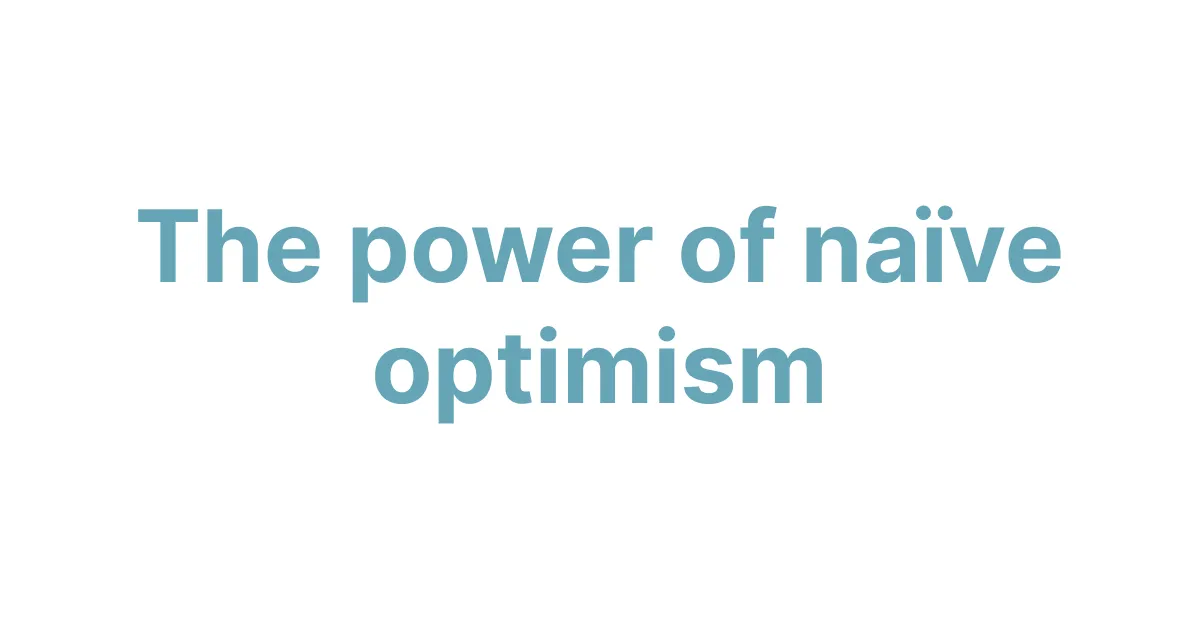
The power of naïve optimism
When is it OK to believe that everything will be OK?
Naïve Optimism can most easily be defined as a belief that good outcomes are more likely (and bad outcomes less likely) in any situation. Naïve optimists believe they’ll land on their feet.
I have no problem admitting that I’m a naïve optimist. So far it’s worked out ok for me – it’s led me to try things and say yes when others may dismiss opportunities as unrealistic and challenges too great.
Yet if you google ‘Naïve Optimism’, you’ll find various scathing takedowns of how annoying and illogical optimists are. To believe that everything will turn out in your favour is, objectively, a bit bonkers. Statistically it doesn’t for most.
Sure, if you google the number of lottery players that end up winning the jackpot there are certainly situations where optimism isn’t going to end well and may even lead to a really negative outcome. But in a situation where you control the variables (for example when talking to humans), I believe that a dose of naïve optimism can be a superpower.
Big Hairy Audiacious Goals
In his book Atomic Habits, James Clear talks about the difference between goals and habits. An analogy he uses which stuck with me is the 100 metre dash. Everyone has the same goal – to win. only 12.5% or 1 of 8 competitors get to actually do it.
But when standing at the blocks, everyone has to have some belief that they’re in with a shot, even if they’re lining up against world record holders. That’s naïve optimism.
Clear uses this analogy to argue that goals are dangerous and building good habits is a far more effective way to get things done. I really enjoyed his book and agree that habits are powerful, but I also love a Big Hairy Audacious Goal (BHAG).
To set a BHAG you need to be a naïve optimist. Hell, starting a business is a BHAG, especially in tech where there’s so much upfront work to get anything going and so many potential competitors. You need a vision and the self belief to think (irrationally) that you’ll be the one to achieve it.
What’s more, if all those sprinters saw was a win/lose binary outcome, they would be missing out on other benefits – for example increased fitness, experience and the opportunity to compete again.
Talking to competitors
So why am I writing about this now? Well my natural predisposition to optimism has been brought into focus by a couple of conversations I’ve had this week.
Those conversations were with two potential competitors. One with the founder of a company at an earlier stage than us, and one founder of a company at a much later stage, with significant money and momentum (you likely will have heard of, or maybe even use them yourself). Neither are doing exactly what we do, but either could become interested in our space very easily.
In both conversations I went in with an attitude of naïve optimism.
With the smaller early stage competitor I had to believe that our combined learnings and momentum would give us an advantage regardless of whether they were building an identical product (which it turned out they weren’t entirely). I also believe that the opportunity is big enough for multiple options to exist, and another business educating the market is a good thing. So knowledge sharing and hearing about another set of opinions was an opportunity too good to miss.
With the larger, well funded business, I thought long and hard about what the potential upside and downside was to the conversation. On the downside, I was potentially showing some leg that would put us at a disadvantage down the line – perhaps revealing insight that would alter their strategy in our direction. On the upside, a company of that size and reputation would make an incredible partner for us as we grow, especially if the problems we’re solving are adjacent, not the same.
A wise advisor said to me:
‘remember that there’s very rarely as much to steal as you think, and it’s often easy to steal without ever meeting you. They just need to find a way to play with the product, which is easy enough.’
Given that, what am I really giving away on a call?
To me, the potential upside beat the downside hands down. So I was comfortable talking pretty openly about our product, stage and plans.
In return I got openness and a bit of insight into how they’re thinking. What’s more I really liked the CEO and hope to build a relationship and look for ways to partner in the future (which will hopefully benefit both businesses and our customers). If I’d been cagey and probing, that might have been the only conversation we’d have, ever.
Be a naïve optimist!
Of course time will tell. My lifetime of naïve optimism may yet come to bite me. But looking for the potential upside (as opposed to all the things that can go wrong) feels like the right course of action right now. And I have to say, I can’t think of many situations where this attitude is the wrong way to go.
To those who keep their ideas close to their chest and hand out NDAs before any conversation – there’s a time and place for that, for sure. But 99% of the time you’re just closing yourself off from opportunity. The upside to sharing and having an attitude of openness is usually significantly higher than the downside, especially when you’re small.
People respond to openness and optimism, so I would encourage you to be an optimist. You may just end up getting everything you want and more.
If anyone’s thinking about building something in this space, reach out! I’d love to hear where you’re coming from, and maybe we can help you out.